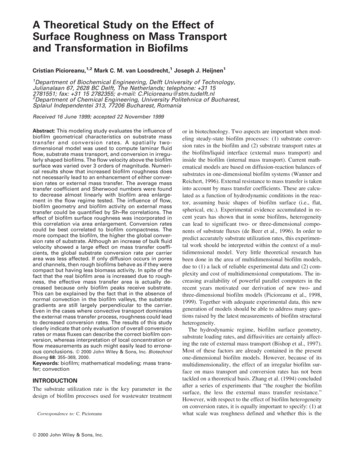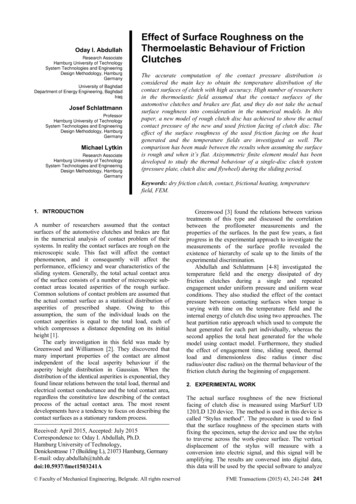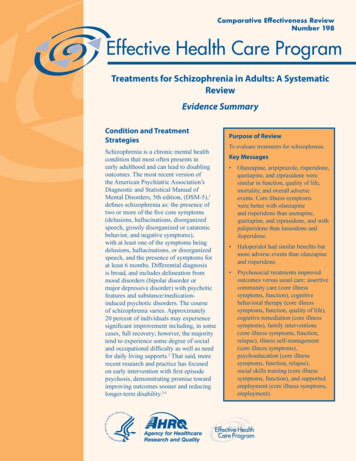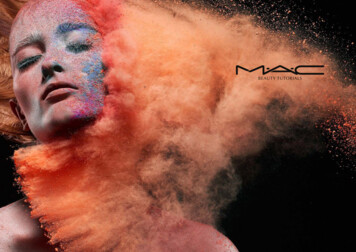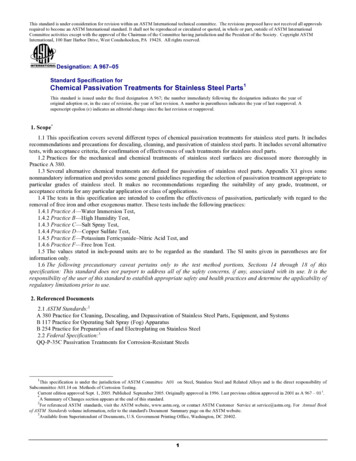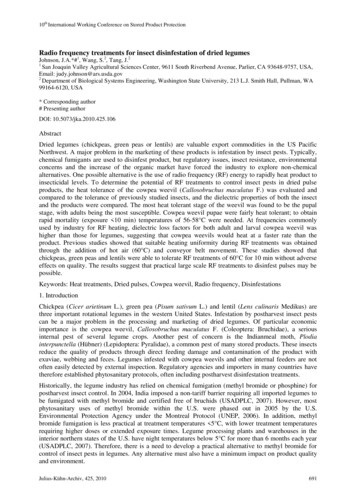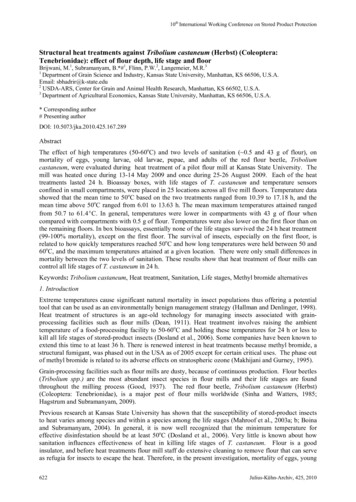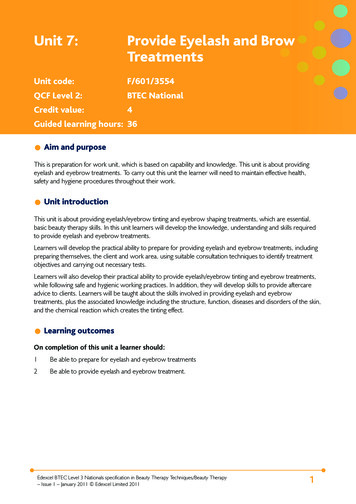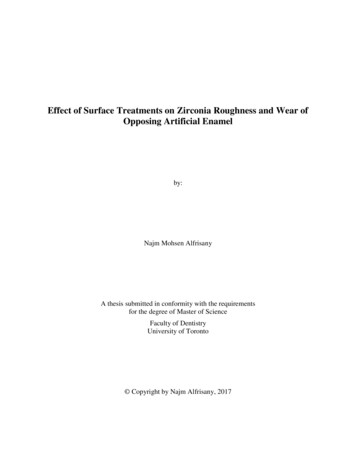
Transcription
Effect of Surface Treatments on Zirconia Roughness and Wear ofOpposing Artificial Enamelby:Najm Mohsen AlfrisanyA thesis submitted in conformity with the requirementsfor the degree of Master of ScienceFaculty of DentistryUniversity of Toronto Copyright by Najm Alfrisany, 2017
Effect of Surface Treatments on Zirconia Roughness and Wear ofOpposing Artificial EnamelNajm Mohsen AlfrisanyMaster of ScienceFaculty of DentistryUniversity of Toronto2017Abstract:Yttria-tetragonal zirconia polycrystal Y-TZP is used in dental restorations. Although occlusaladjustments are often necessary, their effect on Y-TZP surface roughness and tooth wear isunknown. This study investigated the effect of surface condition (Control polished–CPZ; ground–GRZ; repolished–RPZ; Glazed–GZ; Porcelain-veneered–PVZ) on zirconia roughness and wear ofopposing enamel (steatite indenters) after chewing simulation (500,000cycles, 80N, artificialsaliva). A surface profilometer was used to evaluate zirconia roughness (μm) and steatite volumeloss (mm3). Representative specimens from each group were characterized by scanning electronmicroscopy (SEM). Three-way Analysis Variance (ANOVA) and Tukey HSD (p 0.05) showedthat there was a significant interaction effect (p 0.001) between surface condition and CS. CSsignificantly increased roughness of GZ specimens. GRZ showed a smoother surface after CS.Two-way ANOVA and Tukey HSD indicated higher volume loss for indenters abraded directlyagainst zirconia, as opposed to those abraded against porcelain and glaze material.i
TABLES OF CONTENTS1. Chapter 1: Introduction -------------------------------12. Chapter 2: Literature review -------------------------42.1 Parameters and methodologies for wear evaluation -------------------------------------------62.1.1 The design of wear tests -------------------72.1.2 The relevance of wear test ----------82.1.2.1 Force ---------------------------------82.1.2.2 Distance ----------------------------102.1.2.3 Contact time -----------------------102.1.2.4 Sliding movements ---------------112.1.2.5 Antagonist surface ----------------112.1.3 Two-body and three-body wear test -132.1.3.1 Two-body ------------------------142.1.3.2 Three-body wear ------------------142.1.3.3 Three-body wear machines ------152.1.4 Latest technologies employed in wear measurements ---------------------------172.2 Surface properties and --------------------182.2.1 The correlation between roughness, hardness and wear--------------------------18ii
2.2.2 The correlation of aging and -----192.3 Study of wear in ---------------------------212.3.1 Systematic reviews on wear -----212.3.2 Effect of occlusal adjustments -----212.3.3 In vivo zirconia wear ----------------222.3.4 In vitro zirconia --------------------233. Chapter 3: Objectives and ------------------------253.1 .2 ---------------------------------------------254. Chapter 4: Materials and --------------------------264.1 2 Sample ------------------------------------264.3 Experimental -----------------------------284.4 Surface ------------------------------------294.5 Roughness measurement ------------------344.6 Chewing simulation (artificial aging) ---364.7 Evaluation of antagonist wear ------------384.8 statistical -----------------------------------38iii
4.9 Scanning Electron Microscopy (SEM) - 385. Chapter 5: Results -------------------------------------405.1. Roughness evaluation --------------------405.1.1 Analysis of -----------------------------405.1.2 Effect of aging and surface treatment on the roughness of zirconia surface -----425.2 Wear evaluation -----------------------------485.2.1 Analysis of results ----------------------485.2.2 Effect of zirconia surface treatments on the wear of opposing artificial enamel -----486. Chapter 6: Discussion ---------------------------------517. Chapter 7: Conclusion --------------------------------587.1 Future directions -----------------------------588. References ----------------------------------------------59iv
Chapter 1. IntroductionYttria-partially stabilized tetragonal zirconia polycrystal (Y-TZP) is frequently referred toas zirconia. Metal-free dental restorations made of zirconia are one of the most attractive treatmentfor teeth requiring indirect restorations, given zirconia’s biocompatibility, white color and highmechanical properties (Beuer et al., 2012). Zirconia has been the material of choice for frameworksin indirect restorations as opposed to metal, but because of its whitish and opaque color the copingneeds to be veneered with porcelain, and these restorations are frequently referred to as bi-layerrestorations (Tuncel et al., 2013). One of the most common clinical failures found in veneeredzirconia (bi-layer) restorations is the cohesive fracture within the veneering porcelain (Guess etal., 2008).An alternative way to avoid veneer fracture is to exclude the veneering material and tomanufacture monolithic crowns entirely made from zirconia (Long, 2012). This is possible byusing computer-aided-design/computer-aided-manufacture (CAD/CAM) - technology, wheremonolithic crowns can be milled in full anatomical contour. The milling of monolithic crowns hasother advantages such as minimized manufacturing time and improved cost-effectiveness. Insteadof building up the porcelain in several layers and firing in multiple firing cycles, the monolithicrestoration can be personalized by using some staining techniques (Johansson et al., 2013).Monolithic zirconia restorations have been gaining popularity as opposed to the use of bilayer restorations (Raigrodski, 2013) because of the improved translucency of the CAD/CAMzirconia blocks. However, the outstanding mechanical properties of zirconia, such as high hardnessand wear resistance, may have an effect on the opposing natural dentition, especially when therestoration’s surface is not perfectly smooth (Stawarczyk et al., 2013). Under clinical conditions,1
monolithic zirconia crowns seem to cause more wear to the opposing enamel than the humanenamel itself (Stober et al., 2014). This is even more problematic when occlusal adjustments ofmonolithic zirconia crowns are required after installation of the prosthesis. Grinding with adiamond bur is known to increase surface roughness of zirconia (Preis et al., 2015). While thisroughness can be reduced depending on the type of material and technique applied for polishing(Lawson et al., 2014; Rashid, 2014), there is no standard method for polishing monolithic zirconiacrowns yet (Lawson et al., 2014). A glaze layer applied on the surface of zirconia restorations iseasily removed when occlusal adjustments are done or under physiological occlusal loading(Lameira et al., 2017).Interestingly, a recent paper showed that the surface wear of artificial enamel was notaffected by the roughness of different brands of zirconia after grinding and polishing (Preis et al.,2015). However, Amer et al. (2014) observed that material type and surface treatment aresignificant factors that affect wear of opposing human enamel. When different materials werecompared, zirconia and feldspathic porcelain resulted in similar wear to the opposing enamel,which was significantly higher than the wear caused by lithium disilicate ceramic (Amer et al.,2014). A study performed by Lameira et al. (2017) showed that polished zirconia crowns causesignificantly higher wear of artificial enamel than glazed zirconia crowns after 2.5 million cycles.If there is no esthetic demand, a highly polished zirconia is recommended over a glazed onebecause the glaze layer might wear away during function thus exposing the underlying unpolishedsurface to the opposing dentition. Nevertheless, if there is esthetic demand in the area, the zirconiashould be highly polished and then glazed (Janyavula et al., 2013).The applicability of the data available on recent wear and roughness studies is questionable,since low number of cycles (Jung et al., 2010) or low loading force (Stawarczyk et al., 2013) are2
limitations of the methodologies used, compromising the relevance of the roughness data collected(Luangruangrong et al., 2014). Small sample size is also a compromising factor (Lameira et al.,2017). Lack of correlation between number of cycles and time of clinical use may also make theinterpretation of the findings difficult. Therefore, the wear of the opposing enamel caused bymonolithic zirconia restorations with or without occlusal adjustments still needs to be betterinvestigated.3
Chapter 2. Literature ReviewThe wear between human enamel and opposing restorative materials involves a verycomplex mechanism and the selection of a material for minimal wear of opposing enamel is notalways easy. Wear and loss of enamel are unavoidable and may lead to the need for complexrestorative procedures. In fact, the loss of enamel could cause instability of the occlusal balance aswell as unfavorable effects on both natural and artificial dentition (Ramp et al., 1999). A smoothrestoration surface is needed to avoid dental complications such as wear of the opposing dentition,plaque accumulation and other oral problems (Ghazal et al., 2009). It is also needed for the patientcomfort (Ghazal et al., 2009). The two factors that play a role in the wear of the opposing dentitionare roughness and hardness, the rougher the surface and the harder the material the greater will bethe wear volume (Anusavice, 2003).Generally speaking, ceramic materials are known to cause more abrasive wear of humanenamel than other restorative materials, but little information is available concerning the effect ofsurface roughness of monolithic zirconia against the natural dentition (Ramp et al., 1999; Heintzeet al., 2008). The use of different finishing techniques such as diamond burs and polishing kitsmay remove the glazing material of the restoration surface and lead to even more surface roughness(Rashid, 2014; Al-Wahadni & Muir Martin, 1998; Al-Hiyasat et al., 1997). It is consideredimportant to re-establish the smooth or glazed-like zirconia surface using appropriate polishinginstruments to minimize the effect of occlusal adjustments on the wear of the opposing dentition(Ramp et al., 1999; Heintze et al., 2008).To quantify wear between ceramic materials and tooth structure, many materials have beenused as test substrates. Human enamel may be considered the ideal antagonist to be used in terms4
of achieving the real clinical conditions and that is due to its complexity in terms of morphologicaland structural properties. However, many other materials with similar composition have beenwidely used as experimental antagonists such as steatite styluses (Steatite: synthetic materialmainly composed of Magnesium Silicate), ceramic styluses and bovine teeth, which makes it easierto standardize the shape of the antagonist and more precisely quantify wear. In regard to the recentapproach of standardizing enamel cusps by grinding, studies do not mention changes in the wearvolume of the standardized enamel as opposed to the unstandardized enamel antagonists (Krejciet al., 1999; Heintze et al., 2008) Even though steatite may not be considered the ideal alternativeto human enamel in terms of its tribological and mechanical properties, the appropriateness of thesteatite material as an antagonist for in vitro wear studies has been well documented (Wassell etal., 1994a; Wassell et al., 1994b; Hahnel et al., 2009). However, there is no agreement in theliterature as to which material should be used as the antagonist in wear simulation tests (McCabeet al., 2002; Heintze et al., 2006)Two-body and three-body wear tests may be used to investigate the wear characteristics ofa given material. Two-body wear represents the attrition between two opposing surfaces
may remove the glazing material of the restoration surface and lead to even more surface roughness (Rashid, 2014; Al-Wahadni & Muir Martin, 1998; Al-Hiyasat et al., 1997). It is considered important to re-establish the smooth or glazed-like zirconia surface using appropriate polishing instruments to minimize the effect of occlusal adjustments on the wear of the opposing dentition (Ramp et al .
